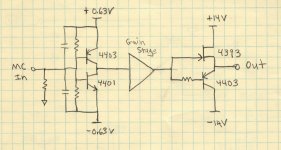The diagram shows the rather unorthodox input and output stages of the MC section of the iPhono2 phono preamp. Since all transistors are general purpose types, I was wondering if better parts could be substituted -especially in the input buffer for lower noise. All parts are SOT-23 surface mount.
Attachments
Maybe this thread could be of some use:
ultra-low noise transistors.
I guess the +0.63 V and -0.63 V are generated with a model circuit that uses the same types of transistors as are used in the input stage. Don't forget to change those as well.
ultra-low noise transistors.
I guess the +0.63 V and -0.63 V are generated with a model circuit that uses the same types of transistors as are used in the input stage. Don't forget to change those as well.
I wonder if anyone has ever looked at what the noise from a transistor is.
For those who do not know, it is tiny, (in a quiet device), drop out.
All renown companies that produced studio recording quality mixing desks, before the ultra low noise IC brigade started, used four or five transistors in parallel. That stopped the noise as not all transistors dropped out at the same time as as long as they all had sufficient gain to cope, there is now an extremely quiet input stage.
For those who do not know, it is tiny, (in a quiet device), drop out.
All renown companies that produced studio recording quality mixing desks, before the ultra low noise IC brigade started, used four or five transistors in parallel. That stopped the noise as not all transistors dropped out at the same time as as long as they all had sufficient gain to cope, there is now an extremely quiet input stage.
4401 and 4403 are actually pretty quiet, although not the quietest. My battery powered MC stage uses the same, although the topology is different from yours. With the MC stage on I cannot hear any increase in the noise floor.
I work on the principle that if I turn it on and I cannot hear any difference with my ear against the speaker then it is good. If it does make a bit of noise but the music sounds good then it’s also good but I might make it quieter one day.
Obviously not everyone has my relaxed measurement method.
I work on the principle that if I turn it on and I cannot hear any difference with my ear against the speaker then it is good. If it does make a bit of noise but the music sounds good then it’s also good but I might make it quieter one day.
Obviously not everyone has my relaxed measurement method.
This is another relevant thread:
Lowest noise BJT transistor?
Regarding Jon's suggestion to put transistors in parallel: paralleling n transistors (at least for AC) essentially reduces the base resistance by a factor of n. For circuits that have to work with very low source impedances, like MC amplifiers, base resistance is usually one of the main noise sources, so paralleling transistors can help a lot.
Lowest noise BJT transistor?
Regarding Jon's suggestion to put transistors in parallel: paralleling n transistors (at least for AC) essentially reduces the base resistance by a factor of n. For circuits that have to work with very low source impedances, like MC amplifiers, base resistance is usually one of the main noise sources, so paralleling transistors can help a lot.
- Status
- Not open for further replies.
